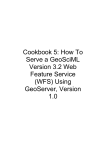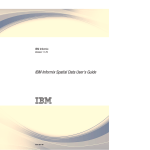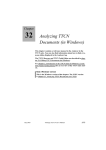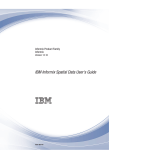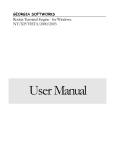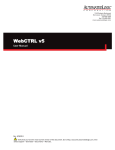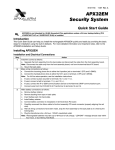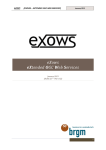Download Implementing an INSPIRE Web Feature Service with
Transcript
Department for Environment Food & Rural Affairs
UK INSPIRE
UK Location Infrastructure
Data Publisher – How To Guide
Implementing an
INSPIRE Web
Feature Service with
GeoServer
UK INSPIRE
DOCUMENT CONTROL
Change Summary
Version
1.0
Date
13 March 2014
Implementing an INSPIRE WFS
Author/Editor
Marcus Sen
Change Summary
Initial version
ii
UK INSPIRE
Contents
Introduction ...................................................................................................................................... 1 Pre-requisites / System Requirements ..................................................................................... 1 Overview ............................................................................................................................................ 2 Installation of Software .................................................................................................................. 4 Database ........................................................................................................................................ 5 GeoServer ...................................................................................................................................... 5 Example Data and Configuration ................................................................................................... 7 Loading example PostGIS data ................................................................................................... 7 Configuring GeoServer WFS ........................................................................................................ 8 INSPIRE Extended Capabilities ................................................................................................. 13 INSPIRE Pre-defined Dataset Download .................................................................................. 15 Complex Feature Configuration ................................................................................................... 15 app-schema.properties ............................................................................................................. 18 Data directory ............................................................................................................................. 19 Workspace layout ....................................................................................................................... 19 datastore.xml ............................................................................................................................. 20 Mapping files ............................................................................................................................... 21 INSPIRE Conformance .................................................................................................................... 27 Pre-defined Dataset Download ................................................................................................ 28 Direct Access Download ............................................................................................................ 33 Implementing an INSPIRE WFS
iii
UK INSPIRE
Introduction
This guidance describes how to set up a web service server using free and open source
Geoserver software to provide an INSPIRE compliant ISO/OGC Web Feature Service (WFS)
version 2.0 for any of the recently published INSPIRE ANNEX I, II or III Data specifications.
It describes how you can implement the WFS functionality described in chapters 6 and 7 of
the latest Technical Guidance for the implementation of INSPIRE Download Services. The
guidance uses the INSPIRE Annex II Geology domain data specification and its
recommendation that the GeoScIML 3.2 encoding schema is used, as this has sufficient
complexity to demonstrate the capabilities of Geoserver version 2.4.5+ ( the first Geoserver
versions capable of providing an INSPIRE compliant WFS) and such that it should give
pointers how to implement any of the INSPIRE ANNEX I, II and III encoding schemas with
Geoserver.
This guidance includes example data and configuration files that can be used to create
running Open GeoSpatial Consortium (OGC) Web Feature Services (WFS) that deliver data
in GeoSciML. This example illustrates aspects of service and data configuration that should
help the reader to set up services using their own data.
This Geoserver open sourced based guidance is the third in a series of ‘Data Publisher How To Guides’ series from UK Location for INSPIRE work the first two being:
Setting up GeoServer on a Windows Machine
Establish a Reference Implementation for an INSPIRE View Service using a
GeoServer
both are available from http://www.data.gov.uk.
Pre-requisites / System Requirements
The cookbook is technical and some assumptions are made about the reader’s background
knowledge:
The reader is a, or is working closely with an expert in the data model and schema
for the particular INSPIRE theme for which they are planning to supply data.
The reader has some familiarity with setting up web servers and preferably Java
servlet containers.
The reader is able to install software on their machine and can follow the appropriate
installation instructions for PostgreSQL, PostGIS and GeoServer documented on the
websites for that software.
Implementing an INSPIRE WFS
1
UK INSPIRE
To set up a production INSPIRE WFS Download service you will need server equipment to
run your database and GeoServer. Estimating the level of hardware resources required to
support a responsive service is a complex task depending on the amount of your data, its
complexity and the demand that will be placed on your service by users. It is out of the
scope of this document to give advice on these issues but you can find some assistance
from the GeoServer web site and mailing list. To test setting up a service using the example
in this guide a modern PC with Intel Core or equivalent processor and 4Gb RAM should
certainly be adequate and you can probably get away with less.
The software required includes the PostgreSQL database with PostGIS spatial extensions,
Java, in most cases a Java servlet container such as Apache Tomcat, and GeoServer itself.
There are a lot of different versions and all these software packages are continuously
updated. You may have conditions specific to your site which make particular versions
preferable. For example, you may already have your data in a different database system
such as Oracle Spatial rather than PostGIS. It isn’t possible to cover all possible set ups
here. We have run the example configuration on Windows 7, Windows Server 2008 OS’s,
with PostgreSQL v8.4 and v9.1 and PostGIS 1.5, Oracle Java 1.6 and 1.7 and GeoServer
2.4.5. Other versions will also be possible but you may encounter particular issues that
require consulting the application documentation or mailing lists. Windows, Linux and Mac
operating systems are all supported by the software used here although installation methods
differ. PostgreSQL v8.4 will reach its end-of-life support in July 2014 so you should probably
select a later version. GeoServer recommends the use of Oracle Java 1.6. See the
GeoServer site for the latest recommendations. At the time of writing (March 2014) there
were still some tests reported failing with Oracle Java 1.7 although we didn’t encounter any
problems in our example service with it. You should use GeoServer 2.4.5 or later as we have
encountered bugs with the complex feature support in earlier versions.
Overview
The text in this cookbook will assume you have your source data in tables in a relational
database system. This is the most likely situation for data of any complexity but you should
be able to adapt the details for other sources such as files etc.
You will need to study the data model for the INSPIRE theme for which you are supplying
data. Having done this you will need to work out a mapping from your source data to
appropriate parts of the INSPIRE theme model. There may be specific guidance for your
INSPIRE theme on how to populate parts of the model (for example, there is a mapping
cookbook for the Geology theme). You will then have the task of configuring your software to
generate XML conformant to your INSPIRE theme schema from your source data. The
structure of your source data may be similar to or quite different from the INSPIRE model
and we can’t cover all possible situations but you will be able to make configuration changes
in two places (i) in your underlying database and (ii) in the WFS software configuration
Implementing an INSPIRE WFS
2
UK INSPIRE
mapping database contents to generated output. A number of constraints; administrative,
performance, flexibility of the WFS software configuration and complexity will govern exactly
how you do this but, as a general principle, it will usually be preferable to do as much in the
database as possible to create source data matching INSPIRE output as closely as possible.
GeoServer can do some quite powerful processing of the underlying data but this is often at
the expense of performance and ability to query the data.
Normally you will have one main table for each feature type you are intending to serve. In a
simple feature WFS each row will generate one feature and the values of the table columns
will be the values contained in simple property values of the generated features (or spatial
data columns generating GML geometry property values). The diagram below shows a table
geol_unit which is mapped to the feature type gsmlgu:GeologicUnit. Two example
text columns description and purpose are mapped directly to simple feature properties
gml:description and gsml:purpose with their text content being put directly inside
the property elements.
With complex features such as in the INSPIRE data specifications there are a number of
ways in which the configuration can be more complex.
A feature property could be 1-1 but its value a complex type with attributes or nested
element content whose values come from the table columns. In the below diagram the
columns of the mapped_feature table are directly placed inside property elements or
attribute values within a complex nested property structure.
Note
Implementing an INSPIRE WFS
3
UK INSPIRE
often attributes like the units of measure may be the same for all rows in your table and you
may want to hard code a value such as “meter” in the service configuration rather than
repeat the same values in every row of your database table.
The property values may be polymorphic having different content structure depending on the
particular data under consideration. A simple example would be nillable properties where the
output structure changes when the property has nil values.
Other complexities include one to many, many to one or many to many relationships
between features and their properties. In these cases you will normally have separate
database tables for the features and their property values (which may be features in their
own right).
Installation of Software
The software used here all has extensive documentation and support forums and mailing
lists. Here we will just point you to the appropriate places to download the software and get
installation instructions.
We assume:
You have a basic familiarity with relational databases
You are able to install applications such as PostGIS, Apache Tomcat, GeoServer etc.
on a server with your chosen operating system using their project documentation.
Implementing an INSPIRE WFS
4
UK INSPIRE
Database
If you already have your data in a relational database system you will want to check the
Working with Databases section of the GeoServer manual to see if your database is
supported by GeoServer and follow the instructions for installation of any extensions that
may be needed for this support. PostGIS support is built into the core GeoServer download.
If you want to try the example data or don’t have a supported database system you should
install PostGIS. The PostGIS Installation page contains instructions on how to do this for
different operating systems. For the purposes of testing this cookbook setup we used the
Enterprise DB Windows Installer which installs the base PostgreSQL database, has an
option to install the PostGIS extension into this and also includes the pgAdmin graphical
database administration tool.
You may use a database on the same machine as GeoServer or you can have it on a
separate machine which is accessible over a network from your GeoServer machine.
GeoServer
GeoServer has extensive documentation which you should refer to in addition to this
cookbook. References will be made to relevant parts rather than repeating too much of what
is already there. There is also a the geoserver-users mailing list.
Assumptions
You will need to have Java installed on the machine on which you are going to install
GeoServer. The GeoServer manual recommends Oracle JRE 6 or later but at the time of
writing (March 2014) GeoServer was not fully tested with Oracle JRE 7. While testing the
example for this document we used Oracle JRE 7 without apparent problems. Some people
have successfully run it with non-Oracle versions of Java but these aren’t supported and you
may need to do extra work and be prepared to enter into technical discussions on the
geoserver-users email list in order to get it working with these.
Ideally you will be familiar with deploying applications in a servlet container application such
as Apache Tomcat or Jetty. If not, however, you can use one of the all-in-one installers to
install a stand-alone version of GeoServer. Also, note that Tomcat and Jetty are the two
most tested servlet containers used with GeoServer so, although you may well be able to
use others, there may be extra work involved and you may need to get advice from the
geoserver-users email list.
Implementing an INSPIRE WFS
5
UK INSPIRE
Basic Installation
Download and install GeoServer following whichever one of the installation paths in
the GeoServer manual suits your situation best. If you already have a servlet
container application such as Apache Tomcat set up or you are familiar with how to
set one up then you will probably wish to download the web archive (WAR) and
deploy that in your servlet container. If you are not comfortable with configuring a
servlet container then you will probably wish to use one of the installer programs.
Run GeoServer at least once to check the installation has worked. If, for example,
you are testing in a local instance of Tomcat on your own machine with default
settings you should be able to visit http://localhost:8080/geoserver and click on the
Layer Preview link to check that the example services shipped with GeoServer work
properly. You will have to modify the preceding URL appropriately if you have
deployed GeoServer on a different machine or port.
App-schema Plugin Installation
Download and install the app-schema plugin geoserver-*-app-schema-
plugin.zip following the application schema installation instructions. Note the
WFS service settings.
Check you can restart GeoServer without any errors being thrown.
INSPIRE Plugin Installation
If you are providing an INSPIRE download service you will need to provide the extra
INSPIRE mandated metadata in the WFS GetCapabilities response.
Download and install the INSPIRE plugin geoserver-*-inspire-plugin.zip
following the INSPIRE plugin installation instructions.
Check that the WFS 1.1.0 and 2.0.0 GetCapabilities responses contain the
inspire_dls:ExtendedCapabilities section.
Implementing an INSPIRE WFS
6
UK INSPIRE
Example Data and Configuration
This tutorial chapter will show you how to set up an INSPIRE Annex II Geology theme
compliant GeoSciML v3.2 WFS using the Open Source GeoServer WFS and PostGIS
spatial database with an example source dataset. It enables you to get some initial
experience setting up a service. Your own services may be set up by customising it or you
may use it to get some understanding of what is involved when setting up your own service.
The tutorial assumes you are familiar with representing complex features in GML
applications.
Loading example PostGIS data
It is assumed that you have installed the PostGIS software and that you have a spatially
enabled database (the default installation will create one called postgis). The following will all
be working within this spatially enabled database.
Download
the
database
dump
file
ftp://ftp.bgs.ac.uk/pubload/OneGeology/INSPIREWFS/inspirewfs.backup.
from
Create a separate schema for the example data. The schema name is used in the database
creation scripts so, if you change it from inspirewfs you will need to edit the scripts
accordingly
CREATE SCHEMA inspirewfs AUTHORIZATION postgres;
Import the data from the database dump file downloaded above. If you have installed the
pgAdmin graphical administration tool you can use the menu option Tools ‣ Restore.... If you
are using the command line you can use the command pg_restore.exe –host localhost –
port 5432 –username “postgres” –dbname “postgis” –no-password –no-owner –noprivileges –no-tablespaces –schema inspirewfs –verbose inspirewfs.backup
(assuming you are using the default ‘postgis’ named database. You should create a
database user with read-only access to these tables for the WFS software to use when
accessing them. With more recent versions of PostgreSQL you can use the shorter syntax to
grant access to all tables in the inspirewfs schema, with older versions you will have to grant
access to each table individually
CREATE ROLE ows_reader LOGIN PASSWORD 'your_password'
VALID UNTIL 'infinity';
COMMENT ON ROLE ows_reader
IS 'A role with read only access to data used in web services.';
grant usage on schema inspirewfs to ows_reader;
Implementing an INSPIRE WFS
7
UK INSPIRE
grant select on table geometry_columns to ows_reader;
grant select on table spatial_ref_sys to ows_reader;
Short syntax for versions of PostgreSQL (works at least as far back as v9.1)
grant select on all tables in schema inspirewfs to ows_reader;
Separate grants for each table for older versions of PostgreSQL (known to be required for
v8.4)
grant select on table inspirewfs.uk_625k_mapped_feature to ows_reader;
grant select on table inspirewfs.uk_625k_geol_unit to ows_reader;
grant select on table inspirewfs.uk_625k_geol_unit_comp_part to ows_reader;
If you have problems with the above steps which are difficult to resolve you may find that
setting log_statement=all in postgresql.conf, reloading the server and then
monitoring the log file is helpful for debugging them.
Configuring GeoServer WFS
Download
the
example
configuration
files
from
ftp://ftp.bgs.ac.uk/pubload/OneGeology/INSPIREWFS/data_625k_inspire.zip and expand it
to a spare location on your server. Copy the files from this expanded directory to the
matching locations in your GeoServer data directory, overwriting any files that already exist
there. The main configuration files are inside the workspaces directory, these shouldn’t
exist in your installation except for the default.xml file which simply defines the example
gsml:MappedFeature to be the default. The files (global.xml, wfs.xml,...) at the top
level of the directory contain service metadata relevant to the example data set. When you
set up your own data you will use the web GUI to change these values. The contents of the
demo directory are some example requests which are documented below.
Copy the file ftp.bgs.ac.uk/pubload/OneGeology/INSPIREWFS/app-schema.properties to
WEB-INF/classes/app-schema.properties and edit the database connection
parameters appropriately for wherever your installation of PostgreSQL is running. If you want
to use a JNDI data connection configured in your servlet container then you will also need to
edit the appropriate places in the datastore.xml files described in a subsequent section.
So it will be easier for initial testing just to enter the host, database, user and password
parameters.
Perform any configuration required by your servlet container, and then start the servlet.
Implementing an INSPIRE WFS
8
UK INSPIRE
One configuration item you may need to change is to increase the memory available for
Java. The method depends on how you have installed GeoServer but if you get
java.lang.OutOfMemoryError: Java heap space errors with the request below
you will need to increase the memory with a directive such as -Xmx256M. The details of
tuning memory and other options of the Java Virtual Machine are complex and not dealt with
in this cookbook. Some information is in the GeoServer User Manual under the Running in a
Production Environment section.
If you have used the Windows Installer you can apply this by editing the file C:\Program
Files (x86)\GeoServer 2.4.5\wrapper\wrapper.conf (The exact file location
will depend on where you installed GeoServer and which version you are using.) Find the
line wrapper.java.maxmemory=128 and increase the value 128 (or whatever it
happens to be) to something like 256.
If you are running in Apache Tomcat on Windows you can use the “Configure Tomcat”
program that the Tomcat Windows installer provides. In the “Java” tab you can put a
maximum memory value such as 256 (MB) in the Maximum Memory pool field.
The first time GeoServer starts with the tutorial configuration, it will download all the
schema (XSD) files it needs and store them in the app-schema-cache folder in
the data directory. You must be connected to the internet for this to work.
Complex Feature Test requests
When GeoServer is running, test app-schema WFS in a web browser. You can query the six
feature types using these links. (Change localhost:8080 in the examples below if you
have deployed it at a different location.):
http://localhost:8080/geoserver/wfs?request=GetFeature&version=2.0.0&
typeName=gsml:MappedFeature&count=25
http://localhost:8080/geoserver/wfs?request=GetFeature&version=2.0.0&
typeName=gsmlgu:GeologicUnit&count=25
You can also obtain WFS responses by using the Demo requests page in the GeoServer
web interface. (Note that the web interface does not yet support app-schema store for layer
administration.) You can select some of the example age and lithology queries from the
request drop-down list or put http://localhost:8080/geoserver/ows into the
service URL section and try pasting in your own queries. The examples are reproduced
below.
Implementing an INSPIRE WFS
9
UK INSPIRE
A query for mapped features showing outcrops of geologic units of a particular age
(WFS_getFeature1GAge.xml)
<?xml version="1.0" encoding="UTF-8"?>
<wfs:GetFeature xmlns:xsi="http://www.w3.org/2001/XMLSchema-instance"
xsi:schemaLocation="
http://www.opengis.net/wfs/2.0
http://schemas.opengis.net/wfs/2.0/wfs.xsd
http://www.opengis.net/gml/3.2
http://schemas.opengis.net/gml/3.2.1/gml.xsd"
xmlns:gsml="http://xmlns.geosciml.org/GeoSciML-Core/3.2"
xmlns:gsmlgu="http://xmlns.geosciml.org/GeologicUnit/3.2"
xmlns:gsmlga="http://xmlns.geosciml.org/GeologicAge/3.2"
xmlns:fes="http://www.opengis.net/fes/2.0"
xmlns:wfs="http://www.opengis.net/wfs/2.0"
xmlns:gml="http://www.opengis.net/gml/3.2"
xmlns:xlink="http://www.w3.org/1999/xlink" count="10" service="WFS"
version="2.0.0" outputFormat="application/gml+xml; version=3.2">
<wfs:Query typeNames="gsml:MappedFeature">
<fes:Filter>
<fes:Or>
<fes:PropertyIsEqualTo>
<fes:ValueReference>gsml:specification/gsmlgu:GeologicUnit/gsml:relatedFeat
ure/gsmlga:GeologicHistory/gsml:relatedFeature/gsmlga:GeologicEvent/gsmlga:
youngerNamedAge/@xlink:href</fes:ValueReference>
<fes:Literal>http://resource.geosciml.org/classifier/ics/ischart/LowerDevon
ian</fes:Literal>
</fes:PropertyIsEqualTo>
<fes:PropertyIsEqualTo>
Implementing an INSPIRE WFS
10
UK INSPIRE
<fes:ValueReference>gsml:specification/gsmlgu:GeologicUnit/gsml:relatedFeat
ure/gsmlga:GeologicHistory/gsml:relatedFeature/gsmlga:GeologicEvent/gsmlga:
youngerNamedAge/@xlink:href</fes:ValueReference>
<fes:Literal>http://resource.geosciml.org/classifier/ics/ischart/Emsian</fe
s:Literal>
</fes:PropertyIsEqualTo>
<fes:PropertyIsEqualTo>
<fes:ValueReference>gsml:specification/gsmlgu:GeologicUnit/gsml:relatedFeat
ure/gsmlga:GeologicHistory/gsml:relatedFeature/gsmlga:GeologicEvent/gsmlga:
youngerNamedAge/@xlink:href</fes:ValueReference>
<fes:Literal>http://resource.geosciml.org/classifier/ics/ischart/Lochkovian
</fes:Literal>
</fes:PropertyIsEqualTo>
<fes:PropertyIsEqualTo>
<fes:ValueReference>gsml:specification/gsmlgu:GeologicUnit/gsml:relatedFeat
ure/gsmlga:GeologicHistory/gsml:relatedFeature/gsmlga:GeologicEvent/gsmlga:
youngerNamedAge/@xlink:href</fes:ValueReference>
<fes:Literal>http://resource.geosciml.org/classifier/ics/ischart/Pragian</f
es:Literal>
</fes:PropertyIsEqualTo>
</fes:Or>
</fes:Filter>
</wfs:Query>
</wfs:GetFeature>
A OneGeology query for mapped features showing outcrops of geological units with
particular lithologies (WFS_getFeature1GLith.xml)
<?xml version="1.0" encoding="UTF-8"?>
<wfs:GetFeature xmlns:xsi="http://www.w3.org/2001/XMLSchema-instance"
xsi:schemaLocation=
"http://www.opengis.net/wfs/2.0
http://schemas.opengis.net/wfs/2.0/wfs.xsd
http://www.opengis.net/gml/3.2
http://schemas.opengis.net/gml/3.2.1/gml.xsd"
xmlns:gsml="http://xmlns.geosciml.org/GeoSciML-Core/3.2"
xmlns:gsmlgu="http://xmlns.geosciml.org/GeologicUnit/3.2"
xmlns:gsmlga="http://xmlns.geosciml.org/GeologicAge/3.2"
xmlns:fes="http://www.opengis.net/fes/2.0"
xmlns:wfs="http://www.opengis.net/wfs/2.0"
xmlns:gml="http://www.opengis.net/gml/3.2"
xmlns:xlink="http://www.w3.org/1999/xlink" count="10" service="WFS"
version="2.0.0" outputFormat="application/gml+xml; version=3.2">
Implementing an INSPIRE WFS
11
UK INSPIRE
<wfs:Query typeNames="gsml:MappedFeature">
<fes:Filter>
<fes:Or>
<fes:PropertyIsEqualTo>
<fes:ValueReference>gsml:specification/gsmlgu:GeologicUnit/gsmlgu:compositi
on/gsmlgu:CompositionPart/gsmlgu:material/gsmlem:RockMaterial/gsmlem:lithol
ogy/@xlink:href</fes:ValueReference>
<fes:Literal>http://inspire.ec.europa.eu/codelist/LithologyValue/limestone<
/fes:Literal>
</fes:PropertyIsEqualTo>
<fes:PropertyIsEqualTo>
<fes:ValueReference>gsml:specification/gsmlgu:GeologicUnit/gsmlgu:compositi
on/gsmlgu:CompositionPart/gsmlgu:material/gsmlem:RockMaterial/gsmlem:lithol
ogy/@xlink:href</fes:ValueReference>
<fes:Literal>http://inspire.ec.europa.eu/codelist/LithologyValue/chalk</fes
:Literal>
</fes:PropertyIsEqualTo>
<fes:PropertyIsEqualTo>
<fes:ValueReference>gsml:specification/gsmlgu:GeologicUnit/gsmlgu:compositi
on/gsmlgu:CompositionPart/gsmlgu:material/gsmlem:RockMaterial/gsmlem:lithol
ogy/@xlink:href</fes:ValueReference>
<fes:Literal>http://inspire.ec.europa.eu/codelist/LithologyValue/travertine
</fes:Literal>
</fes:PropertyIsEqualTo>
</fes:Or>
</fes:Filter>
</wfs:Query>
</wfs:GetFeature>
A bounding box query to retrieve mapped features with shapes that overlap the specified
bounding box (WFS_getFeatureBBOX.xml)
<?xml version="1.0" encoding="UTF-8"?>
<GetFeature xmlns:xsi="http://www.w3.org/2001/XMLSchema-instance"
xsi:schemaLocation="http://www.opengis.net/wfs/2.0
http://schemas.opengis.net/wfs/2.0/wfs.xsd
http://www.opengis.net/gml/3.2
http://schemas.opengis.net/gml/3.2.1/gml.xsd"
xmlns="http://www.opengis.net/wfs/2.0"
xmlns:gsml="http://xmlns.geosciml.org/GeoSciML-Core/3.2"
xmlns:fes="http://www.opengis.net/fes/2.0"
xmlns:xlink="http://www.w3.org/1999/xlink"
xmlns:gml="http://www.opengis.net/gml/3.2" version="2.0.0" service="WFS"
Implementing an INSPIRE WFS
12
UK INSPIRE
count="100">
<Query typeNames="gsml:MappedFeature"
srsName="urn:ogc:def:crs:EPSG::4326">
<fes:Filter>
<fes:BBOX>
<fes:ValueReference>gsml:shape</fes:ValueReference>
<gml:Envelope srsName="urn:ogc:def:crs:EPSG::4326">
<gml:lowerCorner>56.08643859340388 4.0004826736994445</gml:lowerCorner>
<gml:upperCorner>56.165510496146474 3.8381055732299343</gml:upperCorner>
</gml:Envelope>
</fes:BBOX>
</fes:Filter>
</Query>
</GetFeature>
Note
App-schema cannot be configured using the web interface, you will need to edit the
configuration files directly. You will see the configured workspaces and stores appear in the
web interface but not the layers (features). The properties that can be edited in the web
interface are very limited.
INSPIRE Extended Capabilities
If you are providing an INSPIRE download service you will need to provide the extra
INSPIRE mandated metadata in the WFS GetCapabilities response.
As described in the plugin documentation you should find a section in the WFS service
settings of the administration interface where you can choose a language, enter a service
metadata URL and type and add one or more spatial dataset identifiers. For guidance on
what to enter in these settings see the Technical Guidance for the implementation of
INSPIRE Download Services.
Check that the GetCapabilities responses contain your edited values.
Note
The plugin GUI only allows you to select one of two values for the Service Metadata Type:
“Online ISO 19139 ServiceMetadata document” sets the MIME type to
application/vnd.iso.19139+xml, “CSW GetRecord by ID request” sets the MIME
type to application/vnd.ogc.csw.GetRecordByIdResponse_xml. If neither of
these correspond to the actual MIME type of your metadata resource you will need to work
around this by manually editing the wfs.xml file inside the GeoServer data directory as
Implementing an INSPIRE WFS
13
UK INSPIRE
documented in issue GEOS-5157 . On the other hand it isn’t clear whether any client would
actually use this information.
For example, entering the values shown in the screenshot below would result in a
GetCapabilities response with the ExtendedCapabilities section shown below it.
<ows:ExtendedCapabilities>
<inspire_dls:ExtendedCapabilities>
<inspire_common:MetadataUrl
xsi:type="inspire_common:resourceLocatorType">
<inspire_common:URL>
http://metadata.bgs.ac.uk/geonetwork/srv/en/csw?SERVICE=CSW&REQUEST=Get
RecordById&elementSetName=full&OutputSchema=http://www.isotc211.org
/2005/gmd&ID=7822e848-822d-45a5-8584-56d352fd2170&
</inspire_common:URL>
<inspire_common:MediaType>
application/vnd.ogc.csw.GetRecordByIdResponse_xml
</inspire_common:MediaType>
</inspire_common:MetadataUrl>
<inspire_common:SupportedLanguages
xsi:type="inspire_common:supportedLanguagesType">
<inspire_common:DefaultLanguage>
<inspire_common:Language>eng</inspire_common:Language>
</inspire_common:DefaultLanguage>
</inspire_common:SupportedLanguages>
<inspire_common:ResponseLanguage>
<inspire_common:Language>eng</inspire_common:Language>
</inspire_common:ResponseLanguage>
<inspire_dls:SpatialDataSetIdentifier>
<inspire_common:Code>
9df8df51-6342-37a8-e044-0003ba9b0d98
</inspire_common:Code>
</inspire_dls:SpatialDataSetIdentifier>
</inspire_dls:ExtendedCapabilities>
</ows:ExtendedCapabilities>
Implementing an INSPIRE WFS
14
UK INSPIRE
INSPIRE Pre-defined Dataset Download
If you decide that you are going to provide your INSPIRE pre-defined dataset download
service direct from your WFS rather than pre-generating the full datasets and just providing
links to the download through ATOM then you can do this by creating a Stored Query such
as the one below. The example data directory includes the CreateStoredQuery command in
the Demos examples.
<?xml version="1.0" encoding="UTF-8"?>
<wfs:CreateStoredQuery
xmlns:xsi="http://www.w3.org/2001/XMLSchema-instance"
xsi:schemaLocation=
"http://www.opengis.net/wfs/2.0
http://schemas.opengis.net/wfs/2.0/wfs.xsd"
xmlns:gsml="http://xmlns.geosciml.org/GeoSciML-Core/3.2"
xmlns:fes="http://www.opengis.org/fes/2.0"
xmlns:wfs="http://www.opengis.net/wfs/2.0"
xmlns:gml="http://www.opengis.net/gml/3.2"
xmlns:xsd="http://www.w3.org/2001/XMLSchema"
service="WFS"
version="2.0.0">
<wfs:StoredQueryDefinition
id='http://inspire.ec.europa.eu/operation/download/GetSpatialDataSet'>
<wfs:Parameter name='CRS' type='xsd:string'/>
<wfs:Parameter name='DataSetIdCode' type='xsd:string'/>
<wfs:Parameter name='DataSetIdNamespace' type='xsd:string'/>
<wfs:Parameter name='Language' type='xsd:string'/>
<wfs:Parameter name="count" type="xsd:integer"></wfs:Parameter>
<wfs:QueryExpressionText
returnFeatureTypes='gsml:MappedFeature'
language='urn:ogc:def:queryLanguage:OGC-WFS::WFS_QueryExpression'
isPrivate='false'>
<wfs:Query typeNames='gsml:MappedFeature' srsName="${CRS}">
</wfs:Query>
</wfs:QueryExpressionText>
</wfs:StoredQueryDefinition>
</wfs:CreateStoredQuery>
This can then be invoked with a request like:
http://localhost:8080/geoserver/ows?service=wfs&version=2.0.0&request=GetFeature&
storedquery_id=http://inspire.ec.europa.eu/operation/download/GetSpatialDataSet&
DataSetIdCode=13603180&DataSetIdNamespace=http://data.bgs.ac.uk/id/dataHolding/&
CRS=urn:ogc:def:crs:EPSG::4326&Language=eng&count=20&
Complex Feature Configuration
Implementing an INSPIRE WFS
15
UK INSPIRE
This part of the cookbook describes selected parts of the configuration files from the
example set. This should give you a good overview of the configuration files needed and
what the different parts do. They produce valid INSPIRE Annex II Geology theme
(GeoSciML v3.2) features and so, hopefully will provide a good starting point to adapt for
your own services. However, the mapping from your source data to your INSPIRE theme
model may require some features not used in the example. For these cases you should refer
to the Working with Application Schemas section of the GeoServer manual which contains
comprehensive documentation on the different kinds of mapping from source to output XML
that are possible. (It uses GeoSciML v2 based examples.)
Because a single gsmlgu:GeologicUnit can be observed at several distinct locations
on the Earth’s surface, several gsml:MappedFeature features may point via their
gsml:specification property to the same gsmlgu:GeologicUnit.
<?xml version="1.0" encoding="UTF-8"?>
<wfs:FeatureCollection>
<!-- ... -->
<wfs:member>
<gsml:MappedFeature gml:id="bgsn_digmap20111213000014089_625k">
<gml:boundedBy>
<gml:Envelope srsDimension="2" srsName="urn:ogc:def:crs:EPSG::27700">
<gml:lowerCorner>276992.0639999996 693085.1679999997</gml:lowerCorner>
<gml:upperCorner>277851.8129999998 694098.9850000012</gml:upperCorner>
</gml:Envelope>
</gml:boundedBy>
<!-- ... -->
<gsml:shape>
<gml:MultiSurface gml:id="gsml.shape.bgsn_digmap20111213000014089_625k"
srsDimension="2" srsName="urn:ogc:def:crs:EPSG::27700">
<gml:surfaceMember>
<gml:Polygon gml:id="gsml.shape.bgsn_digmap20111213000014089_625k.1"
srsDimension="2">
<gml:exterior>
<gml:LinearRing>
<gml:posList>277851.8129999998 693998.524000001 277823.5400000005
693969.0079999991 277654.64600000007 693696.0569999999
277576.6949999996 693449.1019999995 277550.7119999993
693280.1319999992 277537.7199999998 693085.1679999997
276992.0639999996 693202.1460000003 277018.0469999999
693566.081000001 277134.9740000011 693839.0320000002
277251.8999999991 694098.9850000012 277851.8129999998
693998.524000001</gml:posList>
</gml:LinearRing>
</gml:exterior>
</gml:Polygon>
</gml:surfaceMember>
</gml:MultiSurface>
</gsml:shape>
Implementing an INSPIRE WFS
16
UK INSPIRE
<gsml:specification>
<gsmlgu:GeologicUnit gml:id="SYG-CYCS">
<gml:description>STRATHCLYDE GROUP - SEDIMENTARY ROCK CYCLES,
STRATHCLYDE GROUP TYPE</gml:description>
<!-- ... -->
</gsmlgu:GeologicUnit>
</gsml:specification>
<gsml:metadata xsi:nil="true" gco:nilReason="unpopulated"/>
</gsml:MappedFeature>
</wfs:member>
<wfs:member>
<gsml:MappedFeature gml:id="bgsn_digmap20111213000015084_625k">
<gml:boundedBy>
<gml:Envelope srsDimension="2" srsName="urn:ogc:def:crs:EPSG::27700">
<gml:lowerCorner>280207.97299999953
694960.4289999997</gml:lowerCorner>
<gml:upperCorner>281182.8969999998 696298.8440000011</gml:upperCorner>
</gml:Envelope>
</gml:boundedBy>
<!-- ... -->
<gsml:shape>
<!-- ... -->
</gsml:shape>
<gsml:specification>
<gsmlgu:GeologicUnit gml:id="CKN-CYCC">
<gml:description>CLACKMANNAN GROUP - SEDIMENTARY ROCK CYCLES,
CLACKMANNAN GROUP TYPE</gml:description>
<!-- ... -->
</gsmlgu:GeologicUnit>
</gsml:specification>
<gsml:metadata xsi:nil="true" gco:nilReason="unpopulated"/>
</gsml:MappedFeature>
</wfs:member>
<wfs:member>
<gsml:MappedFeature gml:id="bgsn_digmap20111213000016262_625k">
<gml:boundedBy>
<gml:Envelope srsDimension="2" srsName="urn:ogc:def:crs:EPSG::27700">
<gml:lowerCorner>273924.59599999984
687632.7340000008</gml:lowerCorner>
<gml:upperCorner>276292.57699999935
690639.8490000011</gml:upperCorner>
</gml:Envelope>
</gml:boundedBy>
<!-- ... -->
<gsml:shape>
<!-- ... -->
</gsml:shape>
<gsml:specification xlink:href="#SYG-CYCS"/>
<gsml:metadata xsi:nil="true" gco:nilReason="unpopulated"/>
</gsml:MappedFeature>
</wfs:member>
Implementing an INSPIRE WFS
17
UK INSPIRE
<wfs:member>
<gsml:MappedFeature gml:id="bgsn_digmap20111213000016481_625k">
<gml:boundedBy>
<gml:Envelope srsDimension="2" srsName="urn:ogc:def:crs:EPSG::27700">
<gml:lowerCorner>275822.8000000001 690776.9270000004</gml:lowerCorner>
<gml:upperCorner>277358.40499999985
693332.1230000001</gml:upperCorner>
</gml:Envelope>
</gml:boundedBy>
<!-- ... -->
<gsml:shape>
<!-- ... -->
</gsml:shape>
<gsml:specification xlink:href="#SYG-CYCS"/>
<gsml:metadata xsi:nil="true" gco:nilReason="unpopulated"/>
</gsml:MappedFeature>
</wfs:member>
<wfs:member>
<gsml:MappedFeature gml:id="bgsn_digmap20111213000023007_625k">
<gml:boundedBy>
<gml:Envelope srsDimension="2" srsName="urn:ogc:def:crs:EPSG::27700">
<gml:lowerCorner>247904.646999999 664467.5469999999</gml:lowerCorner>
<gml:upperCorner>289537.88300000026
697616.4020000009</gml:upperCorner>
</gml:Envelope>
</gml:boundedBy>
<!-- ... -->
<gsml:shape>
<!-- ... -->
</gsml:shape>
<gsml:specification xlink:href="#CKN-CYCC"/>
<gsml:metadata xsi:nil="true" gco:nilReason="unpopulated"/>
</gsml:MappedFeature>
</wfs:member>
</wfs:FeatureCollection>
app-schema.properties
This file (in the WEB-INF/classes directory) is not strictly required but is very useful for
storing certain configuration parameters that will be re-used in different parts of the other
configuration files and for storing configuration parameters like database usernames and
passwords outside of the GeoServer data directory so that the latter can be copied freely.
The Property Interpolation section of the GeoServer manual contains more information on
how properties can be set and used in other parts of the configuration files. In the reference
configuration files this contains database connection parameters, some commonly used URI
values and the setting to turn on joining. In fact with current versions of GeoServer (certainly
pre-dating v2.4.5) joining is turned on by default and is the recommended setting. There may
Implementing an INSPIRE WFS
18
UK INSPIRE
be some limited situations as described in the joining documentation, however, when you
need to switch this off.
Data directory
The example configuration files contain a complete GeoServer data directory so that you can
get a working service to try out up and running as quickly as possible. The parts relevant for
configuration of a complex feature WFS are contained in the workspaces directory
described in the next section. The other parts contain items like service metadata, security
etc. and can mostly be set up using the web interface. Thus, when you come to set up your
own service, you will probably start with the default GeoServer data directory, configure
service metadata etc. in the web interface, and copy the complex feature configuration files
from the reference data/workspaces directory to your own data directory for editing there.
Workspace layout
The files for configuring complex feature output are contained in the data/workspaces
directory. Inside this directory there is a sub-directory for each namespace of features you
will be serving and other namespaces that these features may use somewhere in their
content. In the example this includes:
workspaces
├── gco
├── gmd
├── gml
├── gsml
├── gsmlem
├── gsmlga
├── gsmlgs
├── gsmlgu
├── gsmlu
├── swe
└── xlink
These cover all the namespaces used by features in the example data set so, if you are
producing a Geology theme service, it is likely that you will use the same ones. However, for
other themes you will need to create similar directories for the namespaces used in those
themes and, even for the geology theme, you may need to add others if you use additional
GeoSciML packages such as boreholes.
The example configuration defines 2 feature types to be served by the WFS. Their
configurations are stored in data store sub-directories of the appropriate namespace
directory and are named according to the pattern prefix_Feature for a feature
prefix::Feature:
Implementing an INSPIRE WFS
19
UK INSPIRE
workspaces
├── gco
├── gmd
├── gml
├── gsml
│
└── gsml_MappedFeature
├── gsmlem
├── gsmlga
├── gsmlgs
├── gsmlgu
│
└── gsmlgu_GeologicUnit
├── gsmlu
├── swe
└── xlink
Each of the data store directories contains files similar to the following example for
gsml::MappedFeature:
gsml_MappedFeature
├── AppSchemaDataAccess.xsd
├── datastore.xml
├── gsml_MappedFeature
│
└── featuretype.xml
└── gsml_MappedFeature.xml
The AppSchemaDataAccess.xsd file isn’t used for the configuration, it is just provided as
a convenience when you are editing a mapping file such as gsml_MappedFeature.xml
to allow a validating XML editor to give you hints that you have the structure of the file
correct. The following sections will describe the datastore.xml file which creates an
application schema data store and specifies the mapping file described in the section after
which contains the substantive portion of the configuration mapping source data fields to
output in the complex feature types.
datastore.xml
Each data store configuration file datastore.xml specifies the location of a mapping file
and triggers its loading as an app-schema data source. This file should not be confused with
the source data store, which is specified inside the mapping file.
gsml:MappedFeature
the
workspaces/gsml/gsml_MappedFeature/datastore.xml
For
file
is
<dataStore>
<id>gsml_MappedFeature_datastore</id>
<name>gsml_MappedFeature</name>
<enabled>true</enabled>
<workspace>
<id>gsml_workspace</id>
Implementing an INSPIRE WFS
20
UK INSPIRE
</workspace>
<connectionParameters>
<entry key="namespace">http://xmlns.geosciml.org/GeoSciMLCore/3.2</entry>
<entry
key="url">file:workspaces/gsml/gsml_MappedFeature/gsml_MappedFeature.xml</e
ntry>
<entry key="dbtype">app-schema</entry>
</connectionParameters>
</dataStore>
Note
Ensure that there is no whitespace inside an entry element.
For other feature types the pattern is the same where you replace the names and ids
appropriately and change the namespace if necessary. The url entry is a file: URI pointing to
the location of the mapping file relative to the GeoServer data directory. The dbtype entry will
always be app-schema to define complex feature types.
Mapping files
Configuration of app-schema feature types is performed in mapping files e.g.
workspaces/gsmlgu/gsmlgu_GeologicUnit/gsmlgu_GeologicUnit.xml
workspaces/gsml/gsml_MappedFeature/gsml_MappedFeature.xml
Namespaces
Each mapping file contains namespace prefix definitions. The below extract is from
gsml_MappedFeature.xml
<namespaces>
<Namespace>
<prefix>gml</prefix>
<uri>http://www.opengis.net/gml/3.2</uri>
</Namespace>
<Namespace>
<prefix>gsml</prefix>
<uri>http://xmlns.geosciml.org/GeoSciML-Core/3.2</uri>
</Namespace>
<Namespace>
<prefix>gsmlgu</prefix>
<uri>http://xmlns.geosciml.org/GeologicUnit/3.2</uri>
</Namespace>
<Namespace>
Implementing an INSPIRE WFS
21
UK INSPIRE
<prefix>gsmlgs</prefix>
<uri>http://xmlns.geosciml.org/GeologicStructure/3.2</uri>
</Namespace>
<Namespace>
<prefix>swe</prefix>
<uri>http://www.opengis.net/swe/2.0</uri>
</Namespace>
<Namespace>
<prefix>gmd</prefix>
<uri>http://www.isotc211.org/2005/gmd</uri>
</Namespace>
<Namespace>
<prefix>gco</prefix>
<uri>http://www.isotc211.org/2005/gco</uri>
</Namespace>
<Namespace>
<prefix>xlink</prefix>
<uri>http://www.w3.org/1999/xlink</uri>
</Namespace>
<Namespace>
<prefix>xsi</prefix>
<uri>http://www.w3.org/2001/XMLSchema-instance</uri>
</Namespace>
</namespaces>
Only those namespace prefixes used in the mapping file need to be declared although you
may find it easier just to put all the namespaces used by GeoSciML in all of them.
Source data store
The data for this tutorial is contained in the PostGIS database set up in the previous section.
For this example, each feature type uses an identical source data store configuration. The
Parameter elements contain values for various database connection parameters. Here we
are using property interpolation so that these don’t have to get changed in each mapping file
if they change and so that the configuration files can be shared without exposing password
information. The values of the interpolated variables (which have the form ${name}) should
be defined in the WEB-INF/classes/app-schema.properties file. An example
which you can use as a template to fill in with your own values
ftp://ftp.bgs.ac.uk/pubload/OneGeology/INSPIREWFS/app-schema.properties.
is
at
<sourceDataStores>
<DataStore>
<id>datastore</id>
<parameters>
<Parameter>
<name>dbtype</name><value>${cgi.dbtype}</value>
Implementing an INSPIRE WFS
22
UK INSPIRE
</Parameter>
<!-<Parameter>
<name>jndiReferenceName</name><value>${cgi.jndi}</value>
</Parameter>
-->
<Parameter>
<name>host</name><value>${cgi.host}</value>
</Parameter>
<Parameter>
<name>port</name><value>${cgi.port}</value>
</Parameter>
<Parameter>
<name>database</name><value>${cgi.database}</value>
</Parameter>
<Parameter>
<name>user</name><value>${cgi.user}</value>
</Parameter>
<Parameter>
<name>passwd</name><value>${cgi.passwd}</value>
</Parameter>
<Parameter>
<name>schema</name><value>${cgi.schema}</value>
</Parameter>
<Parameter>
<name>Expose primary keys</name><value>true</value>
</Parameter>
</parameters>
</DataStore>
</sourceDataStores>
See
http://docs.geoserver.org/stable/en/user/data/app-schema/data-stores.html
for
a
description of how to use other types of data store.
Target types
The XML Schemas which are required to define a feature type and its properties are
specified in the targetTypes section. The type of the output feature is defined in
targetElement in the typeMapping
gsml_MappedFeature.xml
section.
The
below
example
is
from
<targetTypes>
<FeatureType>
<schemaUri>
http://schemas.geosciml.org/geologicunit/3.2/geologicUnit.xsd
</schemaUri>
</FeatureType>
<FeatureType>
Implementing an INSPIRE WFS
23
UK INSPIRE
<schemaUri>
http://schemas.geosciml.org/geologicstructure/3.2/geologicStructure.xsd
</schemaUri>
</FeatureType>
</targetTypes>
In this case the schema is published, but because the OASIS XML Catalog is used for
schema resolution, a private or modified schema in the catalog can be used if desired.
Mappings
typeMappings
element
gsml_MappedFeature.xml
The
begins
with
configuration
elements.
From
<typeMappings>
<FeatureTypeMapping>
<sourceDataStore>datastore</sourceDataStore>
<sourceType>uk_625k_mapped_feature</sourceType>
<targetElement>gsml:MappedFeature</targetElement>
The mapping starts with sourceDataStore, which gives the arbitrary identifier
used above to name the source of the input data in the sourceDataStores
section.
sourceType gives the name of the source simple feature type. In this case it is the
simple feature type gsml_mappedfeature, sourced from the table of the same
name in the PostGIS database set up in the previous chapter.
When working with databases sourceType is the name of a table or view.
Database identifiers must be lowercase for PostGIS or uppercase for Oracle Spatial.
targetElement is the name of the output complex feature type.
gml:id mapping
The first mapping sets the gml:id to be the feature id specified in the source property file
<AttributeMapping>
<targetAttribute>gsml:MappedFeature</targetAttribute>
<idExpression><OCQL>uuid</OCQL></idExpression>
</AttributeMapping>
targetAttribute is the XPath to the element for which the mapping applies, in
this case, the top-level feature type.
Implementing an INSPIRE WFS
24
UK INSPIRE
idExpression is a special form that can only be used to set the gml:id on a
feature. In the tutorial database we have a column uuid suitable for use as a
gml:id attribute value. If your database doesn’t have such a column you may be
able to use the special function getId() here instead. This will synthesise an id
from the table or view name, a dot ”.”, and the primary key of the table. If this is not
desirable, any other field or CQL expression can be used, if it evaluates to an
NCName.
The above would generate output like
<gsml:MappedFeature gml:id="bgsn_digmap20111213000014089_625k">
...
Ordinary mapping
Most mappings consist of a target and source. Here is a simple property with a text value
from gsmlgu_GeologicUnit.xml
<AttributeMapping>
<targetAttribute>gml:description</targetAttribute>
<sourceExpression>
<OCQL>description</OCQL>
</sourceExpression>
</AttributeMapping>
In this case, the value of gml:description is just the value of the description
column in the uk_625k_geol_unit table.
For a database, the field name is the name of the column (the table/view is set in
sourceType above). Database identifiers must be lowercase for PostGIS or
uppercase for Oracle Spatial.
CQL expressions can be used to calculate content. Use caution because queries on
CQL-calculated values prevent the construction of efficient SQL queries.
Source expressions can be CQL literals, which are single-quoted.
The above would generate output like
<gml:description>STRATHCLYDE GROUP - SEDIMENTARY ROCK CYCLES,
STRATHCLYDE GROUP TYPE</gml:description>
Client properties
Implementing an INSPIRE WFS
25
UK INSPIRE
In addition to the element content, a mapping can set values of XML attributes on property
elements. These are called “client properties” in GeoServer terminology. Here is one from
gsmlgu_CompositionPart.xml
<AttributeMapping>
<targetAttribute>gsmlgu:material/gsmlem:RockMaterial/gsmlem:lithology</targ
etAttribute>
<ClientProperty><name>xlink:href</name><value>insp_lithology_uri</value></C
lientProperty>
<ClientProperty><name>xlink:title</name><value>insp_lithology_label</value>
</ClientProperty>
</AttributeMapping>
This mapping leaves the content of the gsmlem:lithology element empty but
sets an xlink:href attribute to the value of the insp_lithology_uri column
and an xlink:title attribute to the value of the insp_lithology_label
column. Note also that in this case the property attributes being set are nested two
levels below the parent gsmlgu:CompositionPart.
As can be seen from this example, multiple ClientProperty mappings can be set.
This would generate output like
<gsmlem:lithology
xlink:href=
"http://inspire.ec.europa.eu/codelist/LithologyValue/clasticMudstone"
xlink:title="Mudstone"/>
Feature chaining
In feature chaining, one feature type is used as a property of an enclosing feature type, by
value
or
by
reference.
The
following
examples
show
the
parts
of
the
gsml_MappedFeature.xml and gsmlgu_GeologicUnit.xml mapping files that put
the gsmlgu:GeologicFeature elements
gsml:MappedFeature elements.
inside
the
gsml:specification
properties
of
In gsml_MappedFeature.xml
<AttributeMapping>
<targetAttribute>gsml:specification</targetAttribute>
<sourceExpression>
<OCQL>lex_rcs</OCQL>
Implementing an INSPIRE WFS
26
UK INSPIRE
<linkElement>gsmlgu:GeologicUnit</linkElement>
<linkField>FEATURE_LINK</linkField>
</sourceExpression>
</AttributeMapping>
In gsmlgu_GeologicUnit.xml
<AttributeMapping>
<targetAttribute>FEATURE_LINK</targetAttribute>
<sourceExpression><OCQL>lex_rcs</OCQL></sourceExpression>
</AttributeMapping>
In this case from the mapping for gsml:MappedFeature, we specify a mapping for
its gsml:specification property.
The linkElement specifies which feature (or other complex type) should be used
as the value of the property.
The link_specification field of the source gsml_MappedFeature simple
feature is use as the “foreign key”, which maps to the special FEATURE_LINK field
in each gsml:GeologicFeature.
The
mapping
of
the
special
FEATURE_LINK
attribute
in
gsmlgu_GeologicFeature.xml to the foreign key field of the underlying table
means that every gsmlgu:GeologicFeature with lex_rcs equal to the
lex_rcs of the gsml:MappedFeature under construction is included as a
gsml:specification property of the gsml:MappedFeature (by value).
Feature chaining has been used to construct the property gsml:specification of
gsml:MappedFeature. This property is a gsmlgu:GeologicUnit. The WFS response
for gsml:MappedFeature combines the output of both feature types into a single
response. The first gsml:MappedFeature has a gsml:specification property value
of the gsmlgu:GeologicUnit with the same lex_rcs code. The next time a mapped
feature with the same lex_rcs code appears, rather than including the whole geologic unit
inline again the property has an xlink:href attribute pointing to the first occurrence. The
relationships between the feature instances are data driven.
INSPIRE Conformance
In the previous section we have set up, in INSPIRE terminology, both a ‘Web Feature
Service and Filter Encoding Implementation of Pre-defined Dataset Download Service’ and a
‘Web Feature Service and Filter Encoding implementation of Direct Access Download
Service’. The former needs to conform to the requirements set out in chapter 6 and the latter
to the requirements set out in chapter 7 of the Technical Guidance for the implementation of
Implementing an INSPIRE WFS
27
UK INSPIRE
INSPIRE Download Services. We briefly illustrate how the example service conforms to
each requirement below.
Pre-defined Dataset Download
TG Requirement 46
Implementations shall conform to ISO 19142 Conformance Class ‘Simple WFS’
The GetCapabilities response from the service includes the declaration
<ows:Constraint name="ImplementsBasicWFS">
<ows:NoValues/>
<ows:DefaultValue>TRUE</ows:DefaultValue>
</ows:Constraint>
and the WFS 2.0.0 standard states that conforming to the Basic WFS class means also
implementing the Simple WFS conformance class. Running the OGC CITE tests that check
for conformance to the standards is part of the GeoServer build process. This doesn’t
guarantee full conformance, especially as not all the same tests may be run against appschema (?). Apart from the queries getting information about what the service holds like
GetCapabilities, DescribeFeatureType, ListStoredQueries and DescribeStoredQueries, this
conformance class requires that the server at least implements a GetFeature request with
the WFS 2.0.0 standard query to get a feature using its id as shown by the example request
below:
http://localhost:8080/geoserver/ows?service=wfs&version=2.0.0&request=GetFeature&
storedquery_id=urn:ogc:def:query:OGC-WFS::GetFeatureById&id=mf.1&
Note
At the time of writing (Dec 2013) there seems to be a bug so that the above query doesn’t
actually work. See bug report GEOS-6233
TG Requirement 47
Implementations shall conform to ISO 19143 Conformance Class ‘Query’
We can send a query using the wfs:Query element such as the below
<?xml version="1.0" encoding="UTF-8"?>
<wfs:GetFeature xmlns:xsi="http://www.w3.org/2001/XMLSchema-instance"
xsi:schemaLocation=
"http://www.opengis.net/wfs/2.0
Implementing an INSPIRE WFS
28
UK INSPIRE
http://schemas.opengis.net/wfs/2.0/wfs.xsd
http://www.opengis.net/gml/3.2
http://schemas.opengis.net/gml/3.2.1/gml.xsd"
xmlns:gsml="http://xmlns.geosciml.org/GeoSciML-Core/3.2"
xmlns:fes="http://www.opengis.net/fes/2.0"
xmlns:wfs="http://www.opengis.net/wfs/2.0"
xmlns:gml="http://www.opengis.net/gml/3.2"
service="WFS"
version="2.0.0"
outputFormat="application/gml+xml; version=3.2"
count="10">
<wfs:Query typeNames="gsml:MappedFeature">
</wfs:Query>
</wfs:GetFeature>
TG Requirement 48
Implementations shall conform to ISO 19142 Conformance Class ‘HTTP Get’
This is illustrated by an example KVP encoded request like the following:
http://localhost:8080/geoserver/ows?service=wfs&version=2.0.0&request=GetFeature&
typenames=gsml:MappedFeature&count=20&
TG Requirement 49
Pre-defined Stored Queries shall be provided to make pre-defined datasets available.
The stored query with the name specified in the technical guidance can be invoked with the
following query. (Note you must have used the CreateStoredQuery request in the previous
chapter to create the stored query first.)
http://localhost:8080/geoserver/ows?service=wfs&version=2.0.0&request=GetFeature&
storedquery_id=http://inspire.ec.europa.eu/operation/download/GetSpatialDataSet&
DataSetIdCode=13603180&DataSetIdNamespace=http://data.bgs.ac.uk/id/dataHolding/&
CRS=urn:ogc:def:crs:EPSG::4326&Language=eng&count=20&
TG Requirement 50
Any
possible
(i.e.
available)
combinations
of
CRS/DataSetIdCode/DataSetIdNamespace/language shall be made available through predefined stored queries.
Implementing an INSPIRE WFS
29
UK INSPIRE
In
the
example
service
there
is
only
one
combination
of
CRS/DataSetIDCode/DataSetIdNamespace/language available and that is illustrated under
requirement 49 above.
TG Recommendation 13
The following identifier should be used to identify the Stored Query for serving pre-defined
Spatial Data Sets: http://inspire.ec.europa.eu/operation/download/GetSpatialDataSet
This has been implemented as illustrated by the query under requirement 49 above.
TG Requirement 51
Pre-defined Stored Queries shall use the parameter names “CRS”, “DataSetIdCode”,
“DataSetIdNamespace” and “Language” to identify the CRS, dataset ID code, dataset ID
namespace and language components of a query.
The query shown under requirement 49 above shows the use of these parameters.
TG Requirement 52
A separate WFS endpoint shall be provided for each INSPIRE dataset thus providing one
dataset per GetCapabilities response.
Currently there is only one dataset in the example service so this is satisfied trivially.
TG Requirement 53
INSPIRE Metadata for the Download Service shall EITHER be linked to via an
<inspire_common:MetadataURL> in an extended capabilities section, OR the extended
capabilities section shall contain all the INSPIRE Metadata for the Download Service in
accordance with Table 4 and the inspire_dls:ExtendedCapabilities schema.
The example service uses the inspire_common:MetadataURL element as shown below. This
has a dummy URL as the example isn’t a real service and so it isn’t registered in a metadata
catalogue. The INSPIRE plugin GUI described in the previous chapter only allows setting a
MetadataURL. If you wanted to include all the INSPIRE metadata inside the extended
capabilities section itself then you would need to manually edit the xxx file.
<inspire_common:MetadataUrl xsi:type="inspire_common:resourceLocatorType">
<inspire_common:URL>
http://metadata.bgs.ac.uk/geonetwork/srv/en/csw?SERVICE=CSW&
REQUEST=GetRecordById&ID=_id_of_service_to_be_entered_here_&
Implementing an INSPIRE WFS
30
UK INSPIRE
elementSetName=full&OutputSchema=http://www.isotc211.org/2005/gmd&
</inspire_common:URL>
<inspire_common:MediaType>
application/vnd.ogc.csw.GetRecordByIdResponse_xml
</inspire_common:MediaType>
</inspire_common:MetadataUrl>
TG Requirement 54
A network service [Download Service] metadata response shall contain a list of the natural
languages supported by the service. This list shall contain one or more languages that are
supported.
This is included in the extended capabilities section of the GetCapabilities response as
shown below
<inspire_common:SupportedLanguages
xsi:type="inspire_common:supportedLanguagesType">
<inspire_common:DefaultLanguage>
<inspire_common:Language>eng</inspire_common:Language>
</inspire_common:DefaultLanguage>
</inspire_common:SupportedLanguages>
<inspire_common:ResponseLanguage>
<inspire_common:Language>eng</inspire_common:Language>
</inspire_common:ResponseLanguage>
TG Requirement 55
A client may specify a specific language in a request. If the requested language is contained
in the list of supported languages, the natural language fields of the service response shall
be in the requested language. It the requested language is not supported by the service,
then this parameter shall be ignored.
This is trivially supported by the example service as there is only one language supported
and all responses are in that language.
TG Requirement 56
The GetCapabilities operation is extended by an additional parameter that indicates the
client’s preferred language.
The name of this parameter shall be “LANGUAGE”. The parameter values are based on ISO
639-2/B alpha 3 codes as used in [INS MDTG].
Implementing an INSPIRE WFS
31
UK INSPIRE
For the example service the parameter value is ‘eng’ which is the ISO 639-2/B alpha 3 code
for English.
TG Requirement 57
If a client request specifies an unsupported language, or the parameter is absent in the
request, the above fields [Title, Abstract] shall be provided in the service default language.
The response to the following request specifying the unsupported Finnish language is in
English:
http://localhost:8080/geoserver/ows?service=wfs&version=2.0.0&
request=GetCapabilities&language=fin&
TG Requirement 58
The Extended Capabilities shall indicate the response language used for the
GetCapabilities-Response: Depending on the requested language the value of the
<inspire_common:ResponseLanguage> corresponds to the current used language. If a
supported language was requested, <inspire_common:ResponseLanguage> shall
correspond to that requested language. If an unsupported language was requested or if no
specific language was requested <inspire_common:ResponseLanguage> shall correspond
to the service default language <inspire_common:DefaultLanguage>
This is illustrated by the fragment shown under requirement 54.
TG Requirement 59
The Extended Capabilities shall contain the list of supported languages indicated in
<inspire_common:SupportedLanguages>. This list of supported languages shall consist of 1.
exactly one element <inspire_common:DefaultLanguage> indicating the service default
language, and 2. zero or more elements <inspire_common:SupportedLanguage> to indicate
all additional supported languages. Regardless of the response language, the list of
supported languages is invariant for each GetCapabilities-Response.
This is illustrated by the fragment shown under requirement 54.
TG Requirement 60
The Extended Capabilities shall use the XML Schema as defined in the INSPIRE online
schema repository.
Implementing an INSPIRE WFS
32
UK INSPIRE
The example service declares the above schema in the schemaLocation attribute of the
GetCapabilities response as shown below and the response document validates according
to the Schema.
xsi:schemaLocation=
"http://www.opengis.net/wfs/2.0 http://schemas.opengis.net/wfs/2.0/wfs.xsd
http://inspire.ec.europa.eu/schemas/common/1.0
http://inspire.ec.europa.eu/schemas/common/1.0/common.xsd
http://inspire.ec.europa.eu/schemas/inspire_dls/1.0
http://inspire.ec.europa.eu/schemas/inspire_dls/1.0/inspire_dls.xsd"
TG Recommendation 14
For further language support for other operations it is recommended to replace the
operation-online-resources in each language specific GetCapabilities-Response by a
specific operation-online-resource for that language. To support the additional operationonline-resources the service shall listen at the language specific operation end-points to
distinguish for the requested languages.
The example service does not implement this recommendation as it doesn’t support more
than one language anyway.
TG Recommendation 15
The support of IETF RFC 4646 is recommended wherever the support of ISO/639 B alpha3
for languages infringes the conformity with the standard used for implementing the [INS NS].
I think this doesn’t apply to any INSPIRE service as yet as there is no language support
defined in current OGC standards applying to WFS.
Direct Access Download
TG Requirement 61
Implementations shall meet TG Requirement 48 (conformance to [ISO 19142] ‘HTTP GET’
conformance class) and TG Requirement 52 (one endpoint for each INSPIRE dataset).
This is covered under requirements 48 and 52 above.
TG Requirement 62
Implementations shall conform to ISO 19142 Conformance Class ‘Basic WFS’.
Implementing an INSPIRE WFS
33
UK INSPIRE
The comments under requirement 46 in fact also apply to this requirement. A illustration of a
query showing GetFeature with a Query element which is part of the Basic WFS
conformance class but not the Simple WFS conformance class would be the BBOX query
below
<?xml version="1.0" encoding="UTF-8"?>
<wfs:GetFeature xmlns:xsi="http://www.w3.org/2001/XMLSchema-instance"
xsi:schemaLocation=
"http://www.opengis.net/wfs/2.0
http://schemas.opengis.net/wfs/2.0/wfs.xsd
http://www.opengis.net/gml/3.2
http://schemas.opengis.net/gml/3.2.1/gml.xsd"
xmlns:gsml="http://xmlns.geosciml.org/GeoSciML-Core/3.2"
xmlns:fes="http://www.opengis.net/fes/2.0"
xmlns:wfs="http://www.opengis.net/wfs/2.0"
xmlns:gml="http://www.opengis.net/gml/3.2"
service="WFS"
version="2.0.0"
outputFormat="application/gml+xml; version=3.2"
count="10">
<wfs:Query typeNames="gsml:MappedFeature">
<fes:Filter>
<fes:BBOX>
<fes:ValueReference>gsml:shape</fes:ValueReference>
<gml:Envelope>
<gml:lowerCorner>-1.0 51.0</gml:lowerCorner>
<gml:upperCorner>0.0 52.0</gml:upperCorner>
</gml:Envelope>
</fes:BBOX>
</fes:Filter>
</wfs:Query>
</wfs:GetFeature>
TG Requirement 63
A Direct Access Download Service shall conform to ISO 19143 ‘Ad hoc Query’ Conformance
Class.
The age, lithology and BBOX queries described in the previous chapter show various
examples of different queries in this class.
TG Requirement 64
A Direct Access Download Service shall conform to ISO 19143 ‘Resource Identification’
Conformance Class.
Implementing an INSPIRE WFS
34
UK INSPIRE
This is illustrated by the query below
<?xml version="1.0" encoding="UTF-8"?>
<wfs:GetFeature xmlns:xsi="http://www.w3.org/2001/XMLSchema-instance"
xsi:schemaLocation=
"http://www.opengis.net/wfs/2.0
http://schemas.opengis.net/wfs/2.0/wfs.xsd
http://www.opengis.net/gml/3.2
http://schemas.opengis.net/gml/3.2.1/gml.xsd"
xmlns:gsml="http://xmlns.geosciml.org/GeoSciML-Core/3.2"
xmlns:fes="http://www.opengis.net/fes/2.0"
xmlns:wfs="http://www.opengis.net/wfs/2.0"
xmlns:gml="http://www.opengis.net/gml/3.2"
service="WFS"
version="2.0.0"
outputFormat="application/gml+xml; version=3.2"
count="10">
<wfs:Query typeNames="gsml:MappedFeature">
<fes:Filter>
<fes:ResourceId rid="mf.1"/>
</fes:Filter>
</wfs:Query>
</wfs:GetFeature>
TG Requirement 65
A Direct Access Download Service shall conform to ISO 19143 ‘Minimum Standard Filter’
Conformance Class.
This is illustrated by the age and lithology queries in the previous chapter.
TG Requirement 66
A Direct Access Download Service shall conform to ISO 19143 ‘Minimum Spatial Filter’
Conformance Class.
This is illustrated by the BBOX query in the previous chapter.
TG Requirement 67
A Direct Access Download Service shall conform to ISO 19143 ‘Minimum Temporal Filter’
Conformance Class.
The GetCapabilities response states that this is supported as is the ‘During’ filter operation
but the example data does not contain any temporal properties.
Implementing an INSPIRE WFS
35
UK INSPIRE
TG Requirement 68
A Direct Access Download Service shall conform to ISO 19143 ‘Minimum XPath’
Conformance Class.
The age and lithology queries in the previous chapter show the use of XPath to refer to
some nested property values.
© Copyright 2014, NERC. Last updated on Mar 13, 2014. Created using Sphinx 1.2b3.
Implementing an INSPIRE WFS
36







































